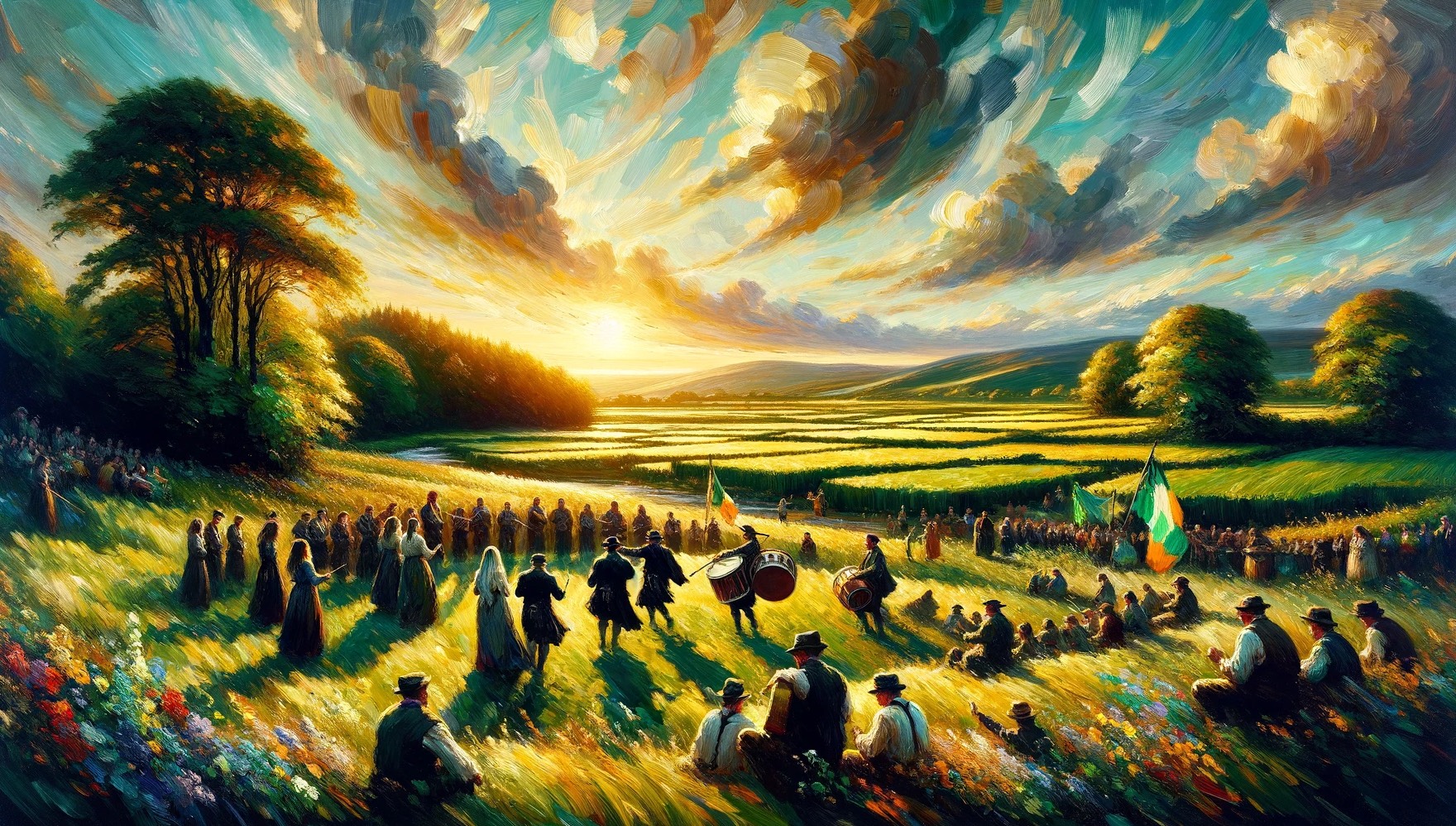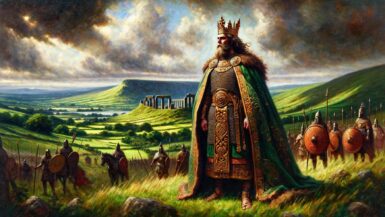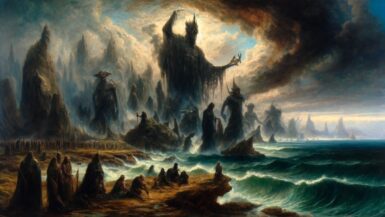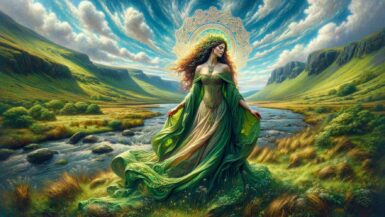In the rich tapestry of Irish mythology, few figures stand out as prominently as Lugh, a deity renowned for his multifaceted roles and profound impact on the ancient tales of Ireland. A member of the Tuatha Dé Danann, the pantheon of pre-Christian gods, Lugh is celebrated for his mastery over numerous skills, making him a symbol of versatility, intelligence, and leadership. His significance in Irish mythology cannot be overstated; he is a warrior of unmatched prowess, a skilled craftsman, a benevolent king, and a guardian of his people. Lugh’s stories are interwoven with themes of heroism, sacrifice, and the cyclical nature of life and death, embodying the complex relationship between humans and the divine in Celtic lore. Through festivals, folklore, and the enduring legacy of ancient manuscripts, Lugh’s presence permeates the cultural and spiritual landscape of Ireland, illustrating the enduring resonance of his character.
Contents
The Origins of Lugh
Lugh’s lineage is as complex and fascinating as the deity himself, rooted in the mythical history of Ireland’s divine and formidable races. He was born to Cian, a member of the Tuatha Dé Danann and a skilled healer, and Ethniu (or Ethliu), the daughter of Balor, the tyrannical leader of the Fomorians. This union between two warring factions— the Tuatha Dé Danann, beings of skill and civilization, and the Fomorians, often depicted as chaotic forces of nature—symbolizes Lugh’s inherent capacity to bridge divides and embody a wide array of powers and virtues.
The circumstances of Lugh’s birth were shrouded in prophecy and intrigue. Balor was foretold to meet his end at the hands of his own grandson, leading him to imprison Ethniu in an attempt to thwart this destiny. However, the intervention of Cian, aided by the druidess Birog, led to the conception of Lugh. To protect the child from Balor’s wrath, Lugh was spirited away and raised by foster parents, including Tailtiu, a former queen of the Fir Bolg. This early life, marked by hidden identity and the nurturing of latent potential, sets the stage for Lugh’s later achievements and challenges.
From these remarkable beginnings, Lugh emerged as a figure of significant power and complexity. His ancestry endowed him with attributes from both the Tuatha Dé Danann and the Fomorians, illustrating the duality of creation and destruction, order and chaos, that he could wield. The prophecies surrounding his birth and rise to prominence underscore the Celtic belief in the inevitability of fate and the interconnectedness of all things, themes that resonate deeply in the stories of Lugh and the broader corpus of Irish mythology.
Lugh’s Epithets and Titles
Lugh is known by several epithets and titles, each reflecting a different facet of his vast repertoire of skills and attributes. These names not only highlight his multifarious talents but also his esteemed status among the pantheon of Celtic gods. Understanding these titles offers a glimpse into the rich cultural and religious fabric of ancient Ireland, showcasing Lugh’s significance in various aspects of life and the natural world.
Lámfada – Perhaps the most well-known of Lugh’s titles, Lámfada translates to “Long Arm” or “Long Hand.” This epithet underscores Lugh’s extraordinary prowess as a warrior, specifically his unmatched skill with a spear that could reach enemies from afar. Beyond its literal martial implications, “Long Arm” also symbolizes Lugh’s far-reaching influence and ability to offer protection and guidance over great distances, embodying his role as a guardian deity.
Samildánach – This title, meaning “Equally Skilled in Many Arts,” perhaps best encapsulates the essence of Lugh’s divine character. Lugh was revered for his proficiency across a broad spectrum of disciplines — from craftsmanship, music, and poetry to warfare, healing, and magic. The name Samildánach highlights his versatility and adaptability, setting him apart as a deity whose talents knew no bounds.
Ildánach – Similar in meaning to Samildánach, Ildánach translates to “Skilled in Many Arts.” This title reinforces Lugh’s role as a master of various crafts and knowledge, underscoring the respect and admiration he garnered as a figure of immense wisdom and capability.
Macnia – Meaning “Youthful Warrior” or “Boy Hero,” this title reflects the stories of Lugh’s extraordinary feats at a young age. It speaks to his early display of heroic qualities and achievements that marked him as a figure of significant power and potential even before reaching full maturity.
Lonnansclech – Translating to “Fierce Striker,” this epithet emphasizes Lugh’s formidable abilities in combat. It portrays him as a fearsome opponent whose martial prowess was unmatched, capable of striking down enemies with devastating force.
Lonnbeimnech – A variant of Lonnansclech, Lonnbeimnech means “Fierce Striker” as well, further accentuating Lugh’s martial excellence and his role as a formidable warrior among the gods.
Lugh as a Deity of Many Talents
Lugh stands out in Irish mythology not just for his heroic deeds but for his extraordinary range of skills and talents, making him a deity revered across various domains of life and nature. His arrival at Tara, the seat of the High Kings of Ireland, and the subsequent demonstration of his abilities, is a tale that encapsulates the essence of his multifaceted character.
Prowess as a Warrior
Lugh’s martial skills are legendary, with his epithet “Lámfada” underscoring his expertise in wielding the spear. Beyond mere physical prowess, Lugh’s strategic acumen in warfare is evidenced in his leadership during the Second Battle of Mag Tuired, where he orchestrated the defeat of the formidable Fomorians. His role as a warrior deity extends to his guardianship over his people, embodying the protective force that champions the cause of justice and righteousness.
Mastery as a Craftsman
Lugh’s talents were not confined to the battlefield. His craftsmanship is celebrated, particularly in the creation and wielding of his magical spear, one of the Tuatha Dé Danann’s treasured possessions. This aspect of his skill set highlights a deeper connection to the elements and the ability to harness their power for the benefit of his people, embodying the synthesis of creativity and utility that characterizes the best of crafts.
Leadership as a King
Ascending to the role of High King after the death of Nuada, Lugh’s leadership was characterized by wisdom, fairness, and an unwavering dedication to the prosperity of his realm. His reign is often depicted as a golden era, marked by peace, fertility, and abundance, reflecting his capacity to bring harmony and balance to the natural and social order.
Master of Various Arts
Lugh’s epithet “Samildánach” reflects his unparalleled versatility and competence in all arts. He was not only a formidable warrior and a skilled craftsman but also a harpist, poet, historian, and a sorcerer. His arrival at Tara is a testament to this, as he offered services that encompassed the entirety of the arts, skills, and crafts known to the Tuatha Dé Danann. When challenged by the gatekeeper of Tara, who claimed that the court already possessed individuals with each of the skills Lugh offered, it was Lugh’s assertion that he mastered all these skills simultaneously that granted him entry, showcasing the unique amalgamation of talents he possessed.
Significance of Lugh’s Arrival at Tara
Lugh’s arrival at Tara is a pivotal moment in Irish mythology, symbolizing the integration of diverse aspects of divinity into the leadership of the Tuatha Dé Danann. It was here that Lugh’s multifaceted talents were recognized and celebrated, leading to his eventual leadership. This event underscores the value placed on versatility, wisdom, and the harmonious balance of skills in leadership. Lugh’s demonstration of his unique abilities not only secured his place in the court of Nuada but also marked the beginning of a new era of prosperity and peace under his guidance.
In Lugh, the ancient Celts found a deity who encapsulated the ideal of excellence in every endeavor, from the arts and crafts to the management of the kingdom and the defense of its people. His story is a celebration of the potential for greatness that lies in the balance and integration of diverse skills and talents.
Key Myths Involving Lugh
Lugh’s narratives in Irish mythology encapsulate his essence as a deity of multifarious talents, showcasing his significance through various pivotal myths.
The Second Battle of Mag Tuired
The Second Battle of Mag Tuired is one of the most defining myths involving Lugh, marking his ascendancy as a leader and a warrior par excellence among the Tuatha Dé Danann. This epic confrontation between the Tuatha Dé Danann and the oppressive forces of the Fomorians, led by the tyrannical Balor, was precipitated by the unjust rule of Bres, a Fomorian king, over the Tuatha Dé Danann. Lugh’s strategic brilliance and warrior prowess were crucial to rallying the Tuatha Dé Danann and preparing them for the impending battle.
The climax of this myth is Lugh’s direct confrontation with Balor, whose deadly gaze was said to wilt life itself. Lugh, however, managed to exploit Balor’s vulnerability by slinging a stone that struck Balor’s lethal eye, driving it through his head and killing him instantly. This act not only saved the Tuatha Dé Danann from certain doom but also fulfilled a prophecy regarding Balor’s death, highlighting Lugh’s destiny as a pivotal figure in Irish mythology.
The Tale of Lughnasadh
Lughnasadh, celebrated on the 1st of August, is a harvest festival instituted by Lugh in honor of his foster mother, Tailtiu. Tailtiu is said to have died of exhaustion after clearing the plains of Ireland for agriculture, her efforts ensuring the prosperity and sustenance of the people. In remembrance of her sacrifices, Lugh established Lughnasadh, a time for communal gatherings, feasts, games, and trading. This festival underscored the importance of harvest, fertility, and communal bonds in Celtic society and showcased Lugh’s role as a nurturer and protector of his people. Lughnasadh celebrations, blending solemnity with joy, continue to be observed in various forms, reflecting the enduring legacy of Lugh’s homage to Tailtiu.
The Tragic Tale of Lugh’s Revenge on Cermait and His Own Demise
The narrative arc of Lugh’s life encompasses not only his heroic deeds and benevolent rulership but also a tale of personal vendetta that led to his tragic demise. Cermait, son of the Dagda, incurred Lugh’s wrath by having an affair with one of Lugh’s wives. Consumed by a desire for revenge, Lugh killed Cermait, setting off a chain of retributive violence. Cermait’s sons, seeking vengeance for their father’s death, ultimately succeeded in killing Lugh, thus enacting the cycle of revenge and tragedy that pervades much of Irish mythology.
This story highlights the complexity of Lugh’s character, portraying him as a deity capable of great love and loyalty, yet susceptible to the very human impulses of jealousy and revenge. Lugh’s demise also signals a transformative moment in the narrative of the Tuatha Dé Danann, as it preludes the decline of their dominion in Irish mythological history.
Lugh’s Legacy and Lughnasadh
Lugh’s impact on Irish mythology and culture extends far beyond the tales of heroism and deity; his legacy is woven into the seasonal fabric of the Irish year through Lughnasadh, a festival that bears his name and honors his contributions to the well-being of the land and its people. This celebration is not only a reflection of Lugh’s historical and mythological significance but also an enduring tradition that has evolved to fit contemporary Irish culture and the practices of neopaganism worldwide.
Celebrating Lughnasadh
Lughnasadh, marked on the 1st of August, heralds the beginning of the harvest season, intertwining agricultural traditions with the commemoration of Lugh’s foster mother, Tailtiu, who is said to have died of exhaustion after clearing the lands of Ireland for cultivation. Lugh instituted the festival in her honor, integrating games, trading, and communal feasts into the observance. This celebration is a testament to Lugh’s role as a nurturer, protector, and a deity deeply connected to the cycles of life and nature.
In ancient times, Lughnasadh was celebrated with hilltop gatherings, market fairs, matchmaking, competitive games, and rituals associated with the harvest. These practices not only facilitated communal bonding and economic exchange but also served to ritualize the transition from summer to autumn, anchoring the community’s seasonal rhythms in the mythic narrative of Lugh’s life and work.
Modern Interpretations and Celebrations
In contemporary Irish culture, Lughnasadh has seen a revival and reinterpretation, especially within neopagan and Celtic spiritual communities. Modern celebrations often blend historical customs with new rituals that seek to connect participants with the cycle of the seasons, the history of the land, and the mythic legacy of Lugh. These may include ceremonial offerings, storytelling, artistic performances, and environmental stewardship activities, reflecting the multifaceted nature of Lugh himself.
Neopagan practices also emphasize the spiritual aspects of Lughnasadh, viewing it as a time for personal growth, reflection on achievements, and the reaping of metaphorical harvests. This modern spiritual dimension underscores Lugh’s association with skill, mastery, and the pursuit of excellence in various endeavors.
Lughnasadh festivals, both in Ireland and among the global Celtic diaspora, often feature traditional music, dance, and craft fairs, connecting participants with Celtic heritage and the communal spirit of the ancient observance. These gatherings serve as a contemporary expression of cultural identity and continuity, celebrating the enduring relevance of Lugh’s mythology in connecting past and present.
Lugh’s Enduring Legacy
Lugh’s legacy, as commemorated through Lughnasadh, transcends the historical and enters the realm of the timeless, embodying themes of sacrifice, renewal, and the cyclical nature of life. It reminds us of the importance of community, the bounty of the earth, and the value of honoring those who came before. Through modern celebrations of Lughnasadh, Lugh remains a vibrant figure in the tapestry of Irish mythological heritage, his stories and significance continually reinterpreted to inspire and resonate with each new generation.
Lugh in Irish History and Culture
Lugh’s presence in Irish history and culture extends far beyond the boundaries of mythic tales, deeply influencing Ireland’s cultural ethos, literature, and the collective consciousness of its people. As a figure emblematic of leadership, protection, and unparalleled skill, Lugh has left an indelible mark on the nation’s identity, weaving his legacy through the very fabric of Irish life and tradition.
Impact on Irish Folklore and Literature
Lugh’s multifaceted nature is mirrored in the diversity of roles he occupies within Irish folklore, from a heroic warrior and benevolent king to a master of arts and a cunning trickster. These aspects of Lugh have permeated Irish literature, inspiring a rich tapestry of storytelling that ranges from ancient epic sagas to contemporary narratives. His tales are imbued with the values of courage, wisdom, and perseverance, reflecting the complexities of human nature and the challenges of the human condition.
In Irish folklore, Lugh’s skills and deeds are often celebrated in the form of oral traditions, poetry, and songs passed down through generations, preserving the cultural memory and historical imagination of the Irish people. These stories serve not only as entertainment but also as moral and educational tools, imparting lessons on leadership, the importance of community, and the connection to the land.
Influence on National Identity
Lugh, as a symbol of unity and strength, has significantly contributed to the shaping of Irish national identity. His legacy as a protector of the realm and a champion of the common good resonates with the Irish spirit of resilience and independence. Lugh’s victory over the oppressive forces of the Fomorians in the Second Battle of Mag Tuired symbolizes the triumph of light over darkness, order over chaos, and has been invoked in times of national struggle and aspiration.
The celebration of Lughnasadh, marking the beginning of the harvest season, further underscores Lugh’s role in the cyclical rhythms of life and the sustenance of the community. This festival, with its roots in gratitude for the bounty of the land, reflects a deep connection to nature that is characteristic of Celtic spirituality and Irish identity.
Conclusion
Lugh’s enduring legacy in Irish mythology, culture, and identity attests to his profound significance as a deity who transcends the confines of myth to inspire and influence the real world. His stories encapsulate the essence of Irish heritage, embodying themes of bravery, ingenuity, and the harmonious balance between man and nature.
As a symbol of skill, leadership, and protection, Lugh continues to resonate with the Irish people and those of Irish descent worldwide, embodying the timeless values that define and distinguish Irish culture. His tales, celebrated in literature, folklore, and festivals, serve as a continual source of inspiration, offering lessons on resilience, creativity, and the power of unity.
In the pantheon of Celtic deities, Lugh stands as a paragon of the ideal hero, whose legacy continues to illuminate the path for generations to come, fostering a sense of pride and belonging that is integral to the Irish national identity. Through the enduring tales of Lugh, Ireland remembers its past, celebrates its present, and looks to the future, secure in the knowledge that the spirit of Lugh, with all his talents and virtues, remains a guiding light in the continuous story of the Irish people.






Leave a reply